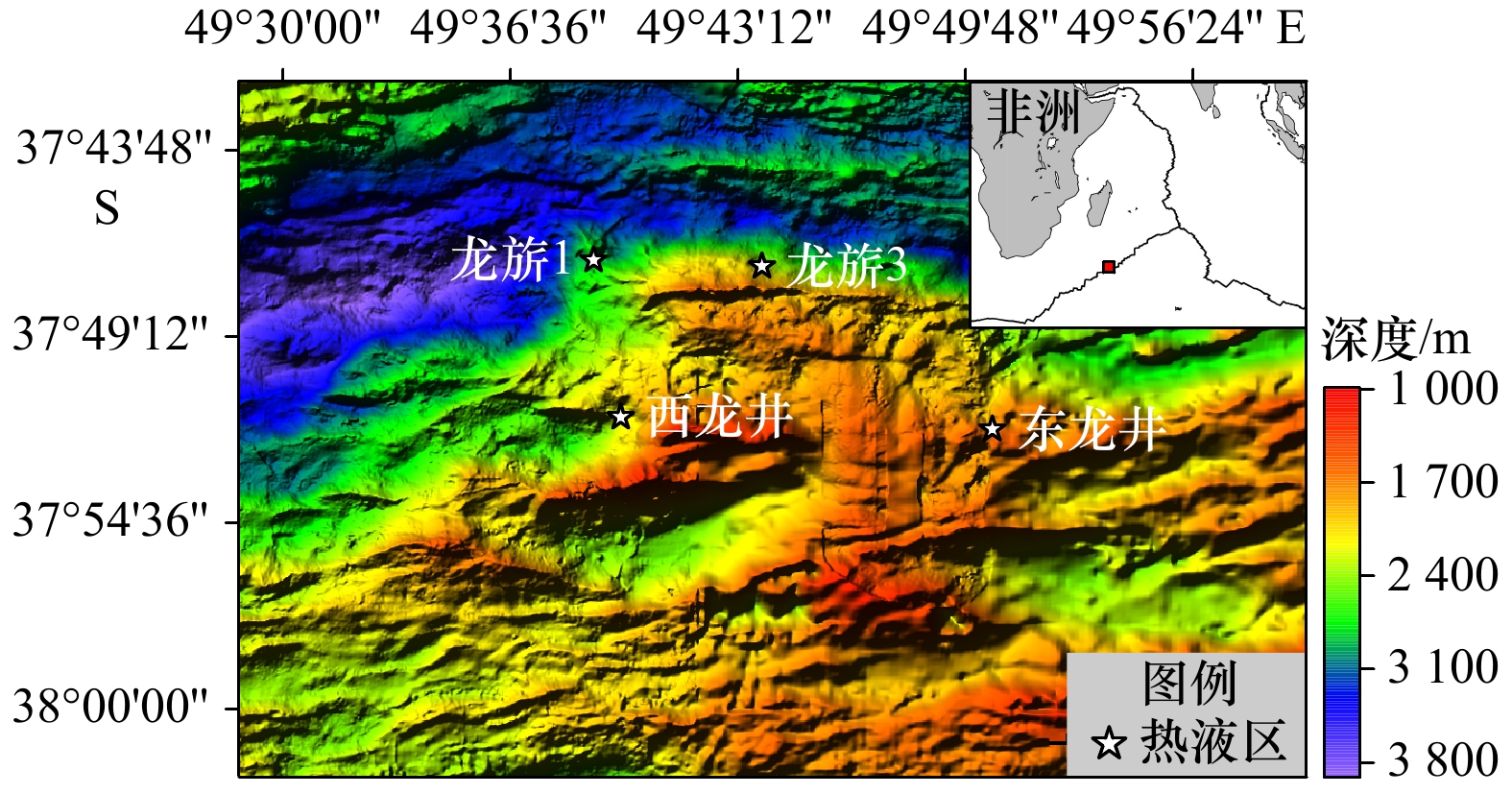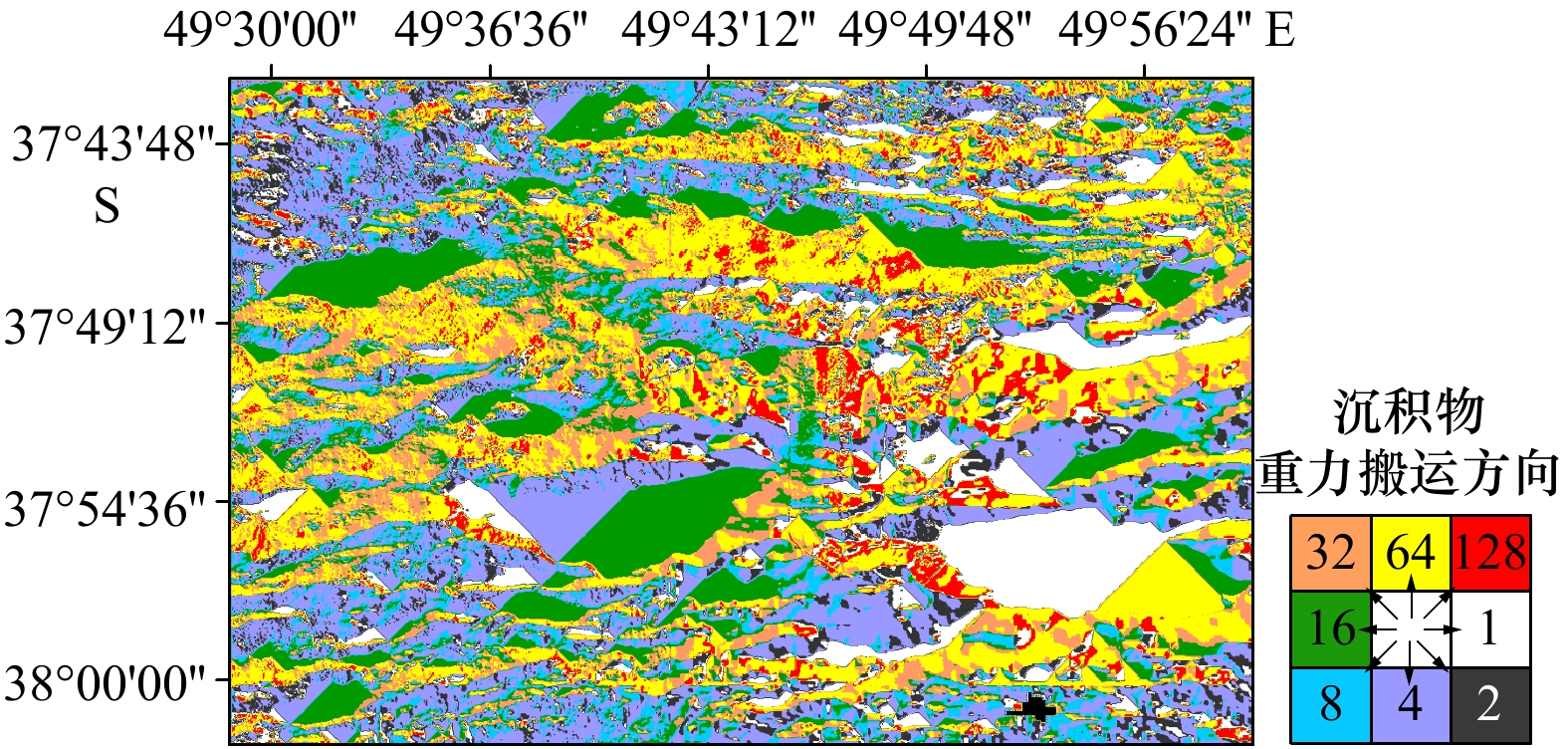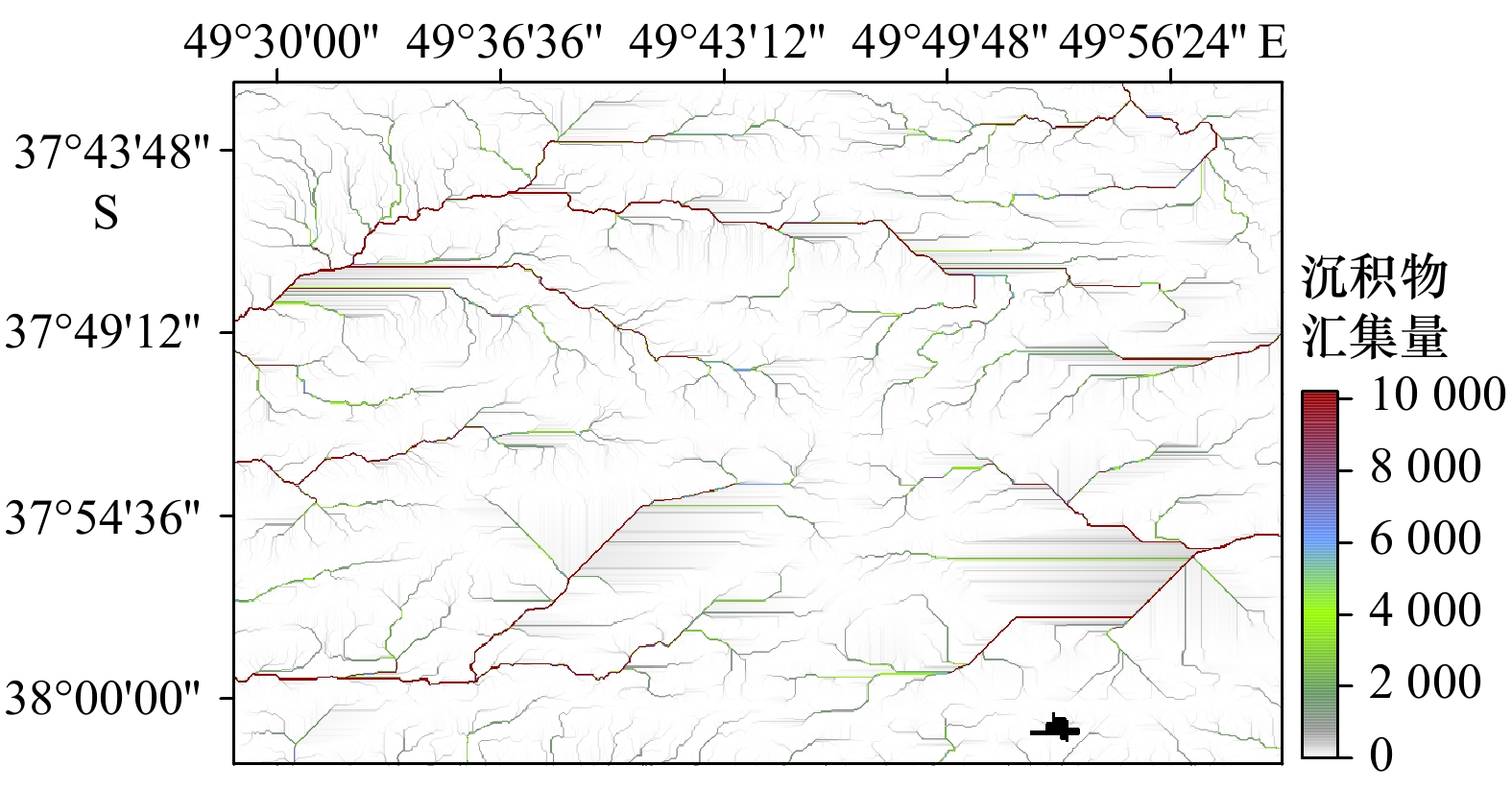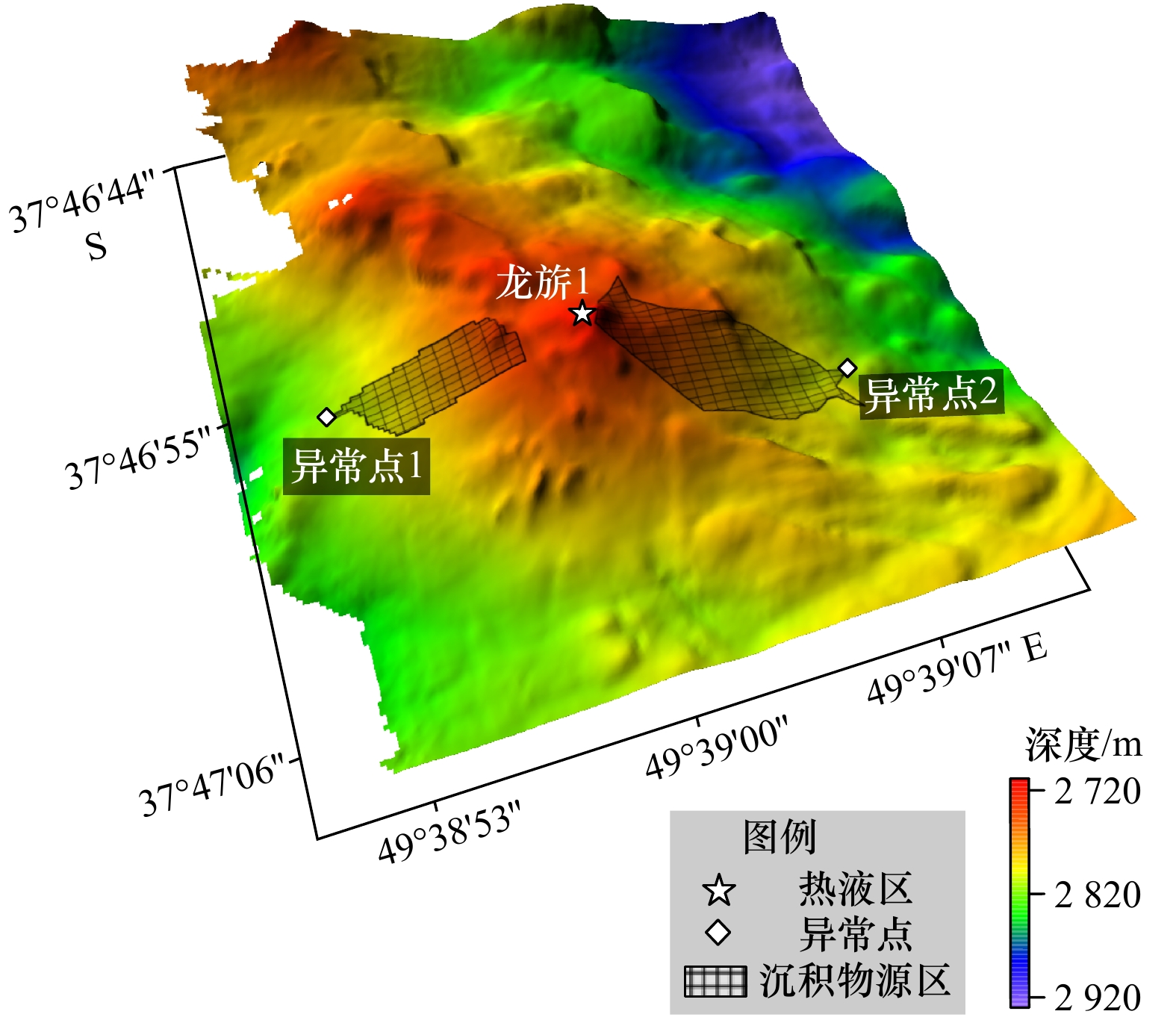Study on prediction method of sediment distribution trend in seafloor hydrothermal field based on topography: A case study of Dragon Horn area on the Southwest Indian Ridge
-
摘要: 热液区沉积物接受了大量热液物质的输入,其矿物组成及地球化学空间分布特征是多金属硫化物勘探的有效指标。由于重力作用,洋中脊区域沉积物主要分布于低洼和平坦地形区。为了探索地形因素对热液区沉积物分布的影响规律,本文通过ArcGIS提出了一种基于地形数据的海底热液区沉积物分布趋势预测方法,并对西南印度洋中脊龙角区地形数据进行了分析,包括沉积物重力搬运方向提取、沉积物汇集量估算、海底沟谷提取和沉积物源区划分。通过与研究区底质解译结果进行对比验证发现,预测结果与研究区内沉积物的实际分布范围较为吻合,表明本方法在一定程度上可以有效地指示地形影响下海底热液区沉积物的分布情况。本方法对海底硫化物矿产勘探工作具有一定指导意义,可为海底沉积物取样站位设置与海底硫化物成矿远景区圈定提供参考依据。Abstract: The sediments in the hydrothermal field received a large amount of hydrothermal input, and their mineral compositions and geochemical spatial distribution characteristics are effective indicators for polymetallic sulfide exploration. Due to gravity, sediments in the mid-ocean ridge area are mainly distributed in low-lying and flat terrain areas. In order to explore the influence of topographical factors on the distribution of sediments in the hydrothermal field, this paper proposes a prediction method of sediment distribution trend in seafloor hydrothermal field based on topography data through ArcGIS, and analyzes the topographic data of Dragon Horn area on the Southwest Indian Ridge, including the extraction gravity transport direction of sediment, the estimation of sediment accumulation amount, the extraction of submarine ditch valley and the division of sediment source area. By comparison and verification with the interpretation results of the seafloor camera data of the study area, we found that the prediction results are in good agreement with the actual distribution range of the sediments in the study area, indicating that this method can effectively indicate the distribution of sediments in the submarine hydrothermal field under the influence of terrain to a certain extent. This method has certain guiding significance for the exploration of submarine sulfide minerals, and could provides a reference basis for the setting of sampling stations for seafloor sediments and the delineation of polymetallic sulfide mineralization prospects.
-
Key words:
- sediment distribution /
- seafloor topography /
- ArcGIS /
- Southwest Indian Ridge /
- seafloor prospecting
-
图 8 研究区海底沟谷网与沉积物分布验证对比
沉积物分布数据来自深拖摄像资料解译,红色框线内为龙角区底质解译工作范围,黄色区域为沉积物分布,数据未发表
Fig. 8 Verification and comparison of the submarine ditch valley network and sediments distribution in the study area
Sediment distribution data come from the interpretation results of the seafloor camera data of the study area. The interpretation working range is shown in the red wireframe, and the yellow area is the sediment distribution, unpublished data
-
[1] 陶春辉. 洋中脊多金属硫化物勘查方法与技术[M]. 北京: 科学出版社, 2018.Tao Chunhui. Exploration Methods and Techniques for Polymetallic Sulfide on the Mid-Ocean Ridges[M]. Beijing: Science Press, 2018. [2] Gurvich E G. Metalliferous Sediments of the World Ocean: Fundamental Theory of Deep-Sea Hydrothermal Sedimentation[M]. Berlin: Springer, 2006. [3] Laurila T E, Hannington M D, Petersen S, et al. Trace metal distribution in the Atlantis II Deep (Red Sea) sediments[J]. Chemical Geology, 2014, 386: 80−100. doi: 10.1016/j.chemgeo.2014.08.009 [4] Yu Zenghui, Li Huaiming, Li Mengxing, et al. Hydrothermal signature in the axial-sediments from the Carlsberg Ridge in the northwest Indian Ocean[J]. Journal of Marine Systems, 2018, 180: 173−181. doi: 10.1016/j.jmarsys.2016.11.013 [5] Nakaseama M, Ishibashi J, Yamanaka T, et al. Hydrothermal circulation within modern sediment layer in submarine volcanoes, Wakaniko crater, south Kyushu, Japan[J]. Geochimica et Cosmochimica Acta, 2006, 70(S18): A441. [6] Poulton S W, Canfield D E. Co-diagenesis of iron and phosphorus in hydrothermal sediments from the southern East Pacific Rise: implications for the evaluation of paleoseawater phosphate concentrations[J]. Geochimica et Cosmochimica Acta, 2006, 70(23): 5883−5898. doi: 10.1016/j.gca.2006.01.030 [7] Rona P A. Hydrothermal mineralization at seafloor spreading centers[J]. Earth-Science Reviews, 1984, 20(1): 1−104. [8] Meinhardt A K, März C, Stein R, et al. Regional variations in sediment geochemistry on a transect across the Mendeleev Ridge (Arctic Ocean)[J]. Chemical Geology, 2014, 369: 1−11. doi: 10.1016/j.chemgeo.2014.01.011 [9] Radke L C, Heap A D, Douglas G, et al. A geochemical characterisation of deep-sea floor sediments of the northern Lord Howe Rise[J]. Deep Sea Research Part II: Topical Studies in Oceanography, 2011, 58(7/8): 909−921. [10] 李诗颖, 吕士辉, 苏新, 等. 西南印度洋龙旂、断桥热液区沉积物中重矿物空间分布特征及其意义[J]. 海洋科学, 2018, 42(2): 10−22. doi: 10.11759/hykx20160928001Li Shiying, Lü Shihui, Su Xin, et al. Heavy-mineralogical distribution characteristics of seafloor sediments from Longqi and Duanqiao hydrothermal fields in Southwest Indian Ridge and their geological inferences[J]. Marine Sciences, 2018, 42(2): 10−22. doi: 10.11759/hykx20160928001 [11] Liao Shili, Tao Chunhui, Li Huaiming, et al. Surface sediment geochemistry and hydrothermal activity indicators in the Dragon Horn area on the Southwest Indian Ridge[J]. Marine Geology, 2018, 398: 22−34. doi: 10.1016/j.margeo.2017.12.005 [12] Li Zhenggang, Chu Fengyou, Jin Lu, et al. Major and trace element composition of surface sediments from the Southwest Indian Ridge: evidence for the incorporation of a hydrothermal component[J]. Acta Oceanologica Sinica, 2016, 35(2): 101−108. doi: 10.1007/s13131-015-0678-8 [13] 梁裕扬, 李家彪, 李守军, 等. 西南印度洋脊中段Indomed-Gallieni洋中脊岩浆—构造动力模式[J]. 地球物理学报, 2014, 57(9): 2993−3005. doi: 10.6038/cjg20140924Liang Yuyang, Li Jiabiao, Li Shoujun, et al. The Magmato-tectonic dynamic model for the Indomed-Gallieni segment of the central southwest Indian ridge[J]. Chinese Journal of Geophysics, 2014, 57(9): 2993−3005. doi: 10.6038/cjg20140924 [14] 张涛, Lin Jian, 高金耀. 西南印度洋中脊热液区的岩浆活动与构造特征[J]. 中国科学: 地球科学, 2013, 43(11): 1834−1846. doi: 10.1360/zd-2013-43-11-1834Zhang Tao, Lin Jian, Gao Jinyao. Magmatism and tectonic processes in area a hydrothermal vent on the Southwest Indian Ridge[J]. Scientia Sinica: Terrae, 2013, 43(11): 1834−1846. doi: 10.1360/zd-2013-43-11-1834 [15] Jenson S K. Applications of hydrologic information automatically extracted from digital elevation models[J]. Hydrological Processes, 1991, 5(1): 31−44. doi: 10.1002/hyp.3360050104 [16] Jain M K, Singh V P. DEM-based modelling of surface runoff using diffusion wave equation[J]. Journal of Hydrology, 2005, 302(1/4): 107−126. [17] Band L E. Topographic partition of watersheds with digital elevation models[J]. Water Resources Research, 1986, 22(1): 15−24. doi: 10.1029/WR022i001p00015 [18] Tao Chunhui, Li Huaiming, Jin Xiaobing, et al. Seafloor hydrothermal activity and polymetallic sulfide exploration on the Southwest Indian Ridge[J]. Chinese Science Bulletin, 2014, 59(19): 2266−2276. doi: 10.1007/s11434-014-0182-0 [19] Tao Chunhui, Lin Jian, Guo Shiqin, et al. First active hydrothermal vents on an ultraslow-spreading center: southwest Indian Ridge[J]. Geology, 2012, 40(1): 47−50. doi: 10.1130/G32389.1 [20] Tao Chunhui, Li Huaiming, Huang Wei, et al. Mineralogical and geochemical features of sulfide chimneys from the 49°39′E hydrothermal field on the Southwest Indian Ridge and their geological inferences[J]. Chinese Science Bulletin, 2011, 56(26): 2828. doi: 10.1007/s11434-011-4619-4 [21] 陈杰, 李怀明, 张涛, 等. 西南印度洋中脊46°E−52.3°E段的岩浆供给特征及机制[C]//2017中国地球科学联合学术年会论文集 (二十八)——专题 56: 海洋地球物理. 北京: 中国地球物理学会, 2017.Chen Jie, Li Huaiming, Zhang Tao, et al. Characteristics and mechanism of magma supply in the 46°E−52.3°E segment of the Southwest Indian Ridge[C]//Proceedings of 2017 Annual Meeting of Chinese Geoscience Union (28)−TOPIC 56: Marine Geophysics. Beijing: Chinese Geophysical Society, 2017. [22] Cannat M, Rommevaux-Jestin C, Sauter D, et al. Formation of the axial relief at the very slow spreading Southwest Indian Ridge (49° to 69°E)[J]. Journal of Geophysical Research: Solid Earth, 1999, 104(B10): 22825−22843. doi: 10.1029/1999JB900195 [23] 王伟, 牛雄伟, 阮爱国, 等. 西南印度洋中脊49.5°E离轴地壳结构[J]. 地球物理学报, 2018, 61(11): 4406−4417. doi: 10.6038/cjg2018L0742Wang Wei, Niu Xiongwei, Ruan Aiguo, et al. Off-axis crustal structure at the Southwest Indian Ridge (49.5°E)[J]. Chinese Journal of Geophysics, 2018, 61(11): 4406−4417. doi: 10.6038/cjg2018L0742 [24] Daniel S, Mathilde C, Christine M, et al. Propagation of a melting anomaly along the ultraslow Southwest Indian Ridge between 46°E and 52°20′E: interaction with the Crozet hotspot?[J]. Geophysical Journal International, 2009, 179(2): 687−699. doi: 10.1111/j.1365-246X.2009.04308.x [25] Meyzen C M, Blichert-Toft J, Ludden J N, et al. Isotopic portrayal of the Earth’s upper mantle flow field[J]. Nature, 2007, 447(7148): 1069−1074. doi: 10.1038/nature05920 [26] 张华添. 极慢速扩张洋中脊构造模式及其成因机制: 以西南印度洋中脊46°−52°E段为例[D]. 北京: 北京大学, 2017.Zhang Huatian. Tectonic model and its genetic mechanism of very-slow spreading ridges: insight from southwest Indian Ridge (46°−52°E)[D]. Beijing: Peking University, 2017. [27] 石春力, 李雪, 孙韧, 等. Arc Hydro模型在流域水文特征提取中的应用——以蓟县沙河流域为例[J]. 水资源与水工程学报, 2012, 23(1): 73−76, 80.Shi Chunli, Li Xue, Sun Ren, et al. Application of Arc Hydro model to extracting hydrological information of Shahe River watershed[J]. Journal of Water Resources and Water Engineering, 2012, 23(1): 73−76, 80. [28] Maidment D R, Morehouse S. Arc Hydro: GIS for Water Resources[M]. Redlands, Calif: ESRI Press, 2002. [29] O’Callaghan J F, Mark D M. The extraction of drainage networks from digital elevation data[J]. Computer Vision, Graphics, and Image Processing, 1984, 28(3): 323−344. doi: 10.1016/S0734-189X(84)80011-0 [30] Jenson S K, Domingue J O. Extracting topographic structure from digital elevation data for geographic information system analysis[J]. Photogrammetric Engineering and Remote Sensing, 1988, 54(11): 1593−1600. [31] Tuppad P, Winchell M F, Wang X, et al. ArcAPEX: ArcGIS interface for agricultural policy environmental eXtender (APEX) hydrology/water quality model[J]. International Agricultural Engineering Journal, 2009, 18(1/2): 59−71. [32] Zhan Xiaoyong, Huang Minlang. ArcCN-Runoff: an ArcGIS tool for generating curve number and runoff maps[J]. Environmental Modelling & Software, 2004, 19(10): 875−879. [33] 陈建平, 任梦依, 方捷, 等. 洋中脊多金属硫化物成矿定量预测[M]. 北京: 科学出版社, 2017.Chen Jianping, Ren Mengyi, Fang Jie, et al. Quantitative Prediction of Polymetallic Sulfide Mineralization in Mid-Ocean ridge[M]. Beijing: Science Press, 2017. [34] Daesslé L W, Cronan D S, Marchig V, et al. Hydrothermal sedimentation adjacent to the propagating Valu Fa Ridge, Lau Basin, SW Pacific[J]. Marine Geology, 2000, 162(2/4): 479−500. [35] Cave R R, German C R, Thomson J, et al. Fluxes to sediments underlying the Rainbow hydrothermal plume at 36°14′N on the Mid-Atlantic Ridge[J]. Geochimica et Cosmochimica Acta, 2002, 66(11): 1905−1923. doi: 10.1016/S0016-7037(02)00823-2 [36] German C R. Hydrothermal activity on the eastern SWIR (50°–70°E): evidence from core–top geochemistry, 1887 and 1998[J]. Geochemistry, Geophysics, Geosystems, 2003, 4(7): 9103. [37] Feely R A, Massoth G J, Baker E T, et al. Tracking the dispersal of hydrothermal plumes from the Juan de Fuca Ridge using suspended matter compositions[J]. Journal of Geophysical Research: Solid Earth, 1992, 97(B3): 3457−3468. doi: 10.1029/91JB03062 [38] Kondratenko A V, Egorov I V, Ivanov V N, et al. Engineering geological study of hydrothermal Polymetallic Sulphides ore fields[C]//The Proceedings of the 27th International Ocean and Polar Engineering Conference. San Francisco: International Society of Offshore and Polar Engineers, 2017. [39] Liao Guanghong, Zhou Beifeng, Liang Chujin, et al. Moored observation of abyssal flow and temperature near a hydrothermal vent on the Southwest Indian Ridge[J]. Journal of Geophysical Research: Oceans, 2016, 121(1): 836−860. doi: 10.1002/2015JC011053 [40] Wang Hu, Yang Qunhui, Ji Fuwu, et al. The geochemical characteristics and Fe (II) oxidation kinetics of hydrothermal plumes at the Southwest Indian Ridge[J]. Marine Chemistry, 2012, 134–135: 29−35. doi: 10.1016/j.marchem.2012.02.009 -





 下载:
下载:








